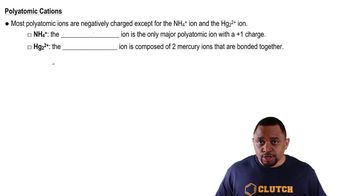Here are the essential concepts you must grasp in order to answer the question correctly.
Polyatomic Ions
Polyatomic ions are ions composed of two or more atoms covalently bonded together, which carry a net charge. Common examples include bicarbonate (HCO₃⁻) and sulfate (SO₄²⁻). Understanding polyatomic ions is essential for naming compounds and writing their formulas, as they often appear in various chemical compounds.
Recommended video:
Iron (Fe) Oxidation States
Iron can exhibit multiple oxidation states, primarily +2 and +3. In the compound Fe(HCO₃)₃, iron is in the +3 oxidation state, which is important for determining the overall charge balance in the compound. Recognizing the oxidation state of transition metals like iron is crucial for correctly naming and writing formulas for coordination compounds.
Recommended video:
States of Matter Example 1
Nomenclature of Ionic Compounds
The nomenclature of ionic compounds involves naming the cation (positive ion) followed by the anion (negative ion). For compounds containing polyatomic ions, the name of the polyatomic ion is used directly. In the case of Fe(HCO₃)₃, the compound is named iron(III) bicarbonate, reflecting the iron's oxidation state and the presence of the bicarbonate ion.
Recommended video:
 Verified step by step guidance
Verified step by step guidance Verified Solution
Verified Solution



 2:11m
2:11m